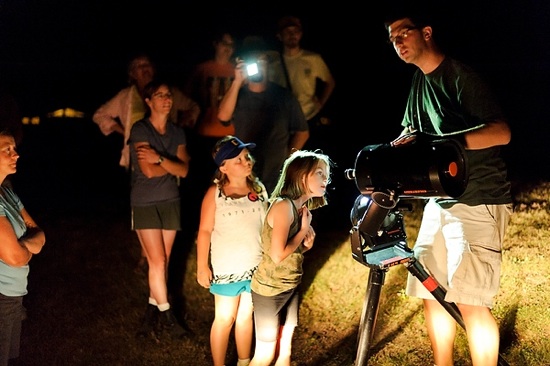Universe in the Park takes astronomy to Wisconsin state parks

Paul Sell introduces guests to the workings of a telescope during a Universe in the Park (UitP) event held outdoors at Governor Dodge State Park in Dodgeville this summer. The outreach program, led by UW–Madison’s Department of Astronomy, includes nearly 50 such events at multiple state parks throughout Wisconsin from May through October.
Photo: Jeff Miller
“I want to blow your mind, take you places you have never seen before. Do not hesitate to ask question. I will not bite.”
Paul Sell is equal parts carnival barker and enthusiastic graduate student as he discusses the size of the universe. As the twilight deepens at the amphitheater at Devil’s Lake State Park, he urges the back-row sitters to move closer, then continues, “The universe is bigger than you can imagine. On its size scale, Earth is like a dust speck.”
The Friday-night session is part of Universe in the Park, a popular outreach program of the University of Wisconsin–Madison Department of Astronomy that was begun in 1996.
“The program is predicated on a very simple idea, that the best environment in which to introduce the general public to astronomy is outside under dark skies,” says Eric Wilcots, a professor of astronomy who administers the program.
The program ran through the summer and continues through Oct. 31 in state-park campgrounds. All told, about 50 sessions will be held this year.
Sessions begin just after sunset with a brief talk and slide show that present a broad overview of astronomy or recent astronomical news. The questions come quickly.
“Why is Pluto no longer called a planet?” Because, Sell explains, Pluto was downgraded to “dwarf planet” after the discovery of dozens of similar objects that, like Pluto, had too little mass to clear smaller objects out of their orbits.
If that isn’t persuasive, he asks, “Who wants to memorize the names of 20 or more planets?”
Although Pluto’s demotion has upset some people, “I think it’s pretty cool,” says Sell. “We have learned something, and so we changed our terminology. We do this all the time in medicine and other fields.”
Sell then discusses the concept of the light year – the distance light travels in one year, and explains that while it seems instantaneous on Earth, light can take billions of years to travel from the most distant objects. During that time, the galaxies that made the light could have evolved into different shapes, sizes, and colors.
Most in the audience of about 30 are camping at the park tonight, but a few, including Tim McInerney of Sauk City, have come specifically for the event. “It was awesome, he was a very good presenter; it was really mind-blowing,” says McInerney. “I think we are not alone in the universe.”
As twilight fades to night, the action shifts to a small telescope that Anna Williams, another astronomy grad student, has set up in the campground. First target is Saturn, which has almost set on the western horizon.
As the group queues behind the scope and Sell and Williams take on all questions, it’s clear that this National Science Foundation funded project is hitting the mark. “It was great, I learned a lot I did not know,” says Robin Jachthuber of Montello. “It makes you want to look into it, and find out more; it certainly held my attention.”
Katya Sibo and son Carlos, from Arlington, Texas, were visiting her parents. “I learned a lot, and it was painless,” says Sibo. “Carlos is into all things astronomical. I did not think about how when we look up, what we see is not what is happening now.”
Subscribe to Wisconsin Ideas
Want more stories of the Wisconsin Idea in action? Sign-up for our monthly e-newsletter highlighting how Badgers are taking their education and research beyond the boundaries of the classroom to improve lives.

